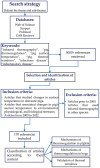Thermoregulation mechanisms and perspectives for validating thermal windows in pigs with hypothermia and hyperthermia: An overview
- PMID: 36532356
- PMCID: PMC9751486
- DOI: 10.3389/fvets.2022.1023294
Thermoregulation mechanisms and perspectives for validating thermal windows in pigs with hypothermia and hyperthermia: An overview
Abstract
Specific anatomical characteristics make the porcine species especially sensitive to extreme temperature changes, predisposing them to pathologies and even death due to thermal stress. Interest in improving animal welfare and porcine productivity has led to the development of various lines of research that seek to understand the effect of certain environmental conditions on productivity and the impact of implementing strategies designed to mitigate adverse effects. The non-invasive infrared thermography technique is one of the tools most widely used to carry out these studies, based on detecting changes in microcirculation. However, evaluations using this tool require reliable thermal windows; this can be challenging because several factors can affect the sensitivity and specificity of the regions selected. This review discusses the thermal windows used with domestic pigs and the association of thermal changes in these regions with the thermoregulatory capacity of piglets and hogs.
Keywords: heat stress; hog; hypothermia; infrared thermography; piglet.
Copyright © 2022 Gómez-Prado, Pereira, Wang, Villanueva-García, Domínguez-Oliva, Mora-Medina, Hernández-Avalos, Martínez-Burnes, Casas-Alvarado, Olmos-Hernández, Ramírez-Necoechea, Verduzco-Mendoza, Hernández, Torres and Mota-Rojas.
Conflict of interest statement
The authors declare that the research was conducted in the absence of any commercial or financial relationships that could be construed as a potential conflict of interest.
Figures







Similar articles
-
Clinical Applications and Factors Involved in Validating Thermal Windows Used in Infrared Thermography in Cattle and River Buffalo to Assess Health and Productivity.Animals (Basel). 2021 Jul 30;11(8):2247. doi: 10.3390/ani11082247. Animals (Basel). 2021. PMID: 34438705 Free PMC article. Review.
-
Neonatal infrared thermography images in the hypothermic ruminant model: Anatomical-morphological-physiological aspects and mechanisms for thermoregulation.Front Vet Sci. 2022 Aug 4;9:963205. doi: 10.3389/fvets.2022.963205. eCollection 2022. Front Vet Sci. 2022. PMID: 35990264 Free PMC article. Review.
-
Experimental Applications and Factors Involved in Validating Thermal Windows Using Infrared Thermography to Assess the Health and Thermostability of Laboratory Animals.Animals (Basel). 2021 Dec 3;11(12):3448. doi: 10.3390/ani11123448. Animals (Basel). 2021. PMID: 34944225 Free PMC article. Review.
-
Strategies for Hypothermia Compensation in Altricial and Precocial Newborn Mammals and Their Monitoring by Infrared Thermography.Vet Sci. 2022 May 23;9(5):246. doi: 10.3390/vetsci9050246. Vet Sci. 2022. PMID: 35622774 Free PMC article. Review.
-
Impact of housing environment and management on pre-/post-weaning piglet productivity.J Anim Sci. 2022 Jun 1;100(6):skac142. doi: 10.1093/jas/skac142. J Anim Sci. 2022. PMID: 35708591 Free PMC article. Review.
Cited by
-
Caffeine Administration in Piglets with Low Birthweight and Low Vitality Scores, and Its Effect on Physiological Blood Profile, Acid-Base Balance, Gas Exchange, and Infrared Thermal Response.Animals (Basel). 2023 Nov 12;13(22):3491. doi: 10.3390/ani13223491. Animals (Basel). 2023. PMID: 38003109 Free PMC article.
-
Use of Infrared Thermography and Heart Rate Variability to Evaluate Autonomic Activity in Domestic Animals.Animals (Basel). 2024 May 1;14(9):1366. doi: 10.3390/ani14091366. Animals (Basel). 2024. PMID: 38731370 Free PMC article. Review.
-
Strategies and Mechanisms of Thermal Compensation in Newborn Water Buffaloes.Animals (Basel). 2023 Jun 30;13(13):2161. doi: 10.3390/ani13132161. Animals (Basel). 2023. PMID: 37443964 Free PMC article. Review.
-
Hypothalamic Neuromodulation and Control of the Dermal Surface Temperature of Livestock during Hyperthermia.Animals (Basel). 2024 Jun 9;14(12):1745. doi: 10.3390/ani14121745. Animals (Basel). 2024. PMID: 38929364 Free PMC article. Review.
-
Hypothalamic Neuromodulation of Hypothermia in Domestic Animals.Animals (Basel). 2024 Feb 4;14(3):513. doi: 10.3390/ani14030513. Animals (Basel). 2024. PMID: 38338158 Free PMC article. Review.
References
-
- Rizzo M, Arfuso F, Giudice E, Abbate F, Longo F, Piccione G. Core and surface temperature modification during road transport and physical exercise in horse after acupuncture needle stimulation. J Equine Vet Sci. (2017) 55:84–9. 10.1016/j.jevs.2017.03.224 - DOI
-
- Gianesella M, Arfuso F, Fiore E, Giambelluca S, Giudice E, Armato L, et al. . Infrared thermography as a rapid and non-invasive diagnostic tool to detect inflammatory foot diseases in dairy cows. Pol J Vet Sci. (2018)21:299–305. - PubMed
-
- Arfuso F, Acri G, Piccione G, Sansotta C, Fazio F, Giudice E, et al. . Eye surface infrared thermography usefulness as a noninvasive method of measuring stress response in sheep during shearing: Correlations with serum cortisol and rectal temperature values. Physiol Behav. (2022) 250:113781. 10.1016/j.physbeh.2022.113781 - DOI - PubMed
Publication types
LinkOut - more resources
Full Text Sources

